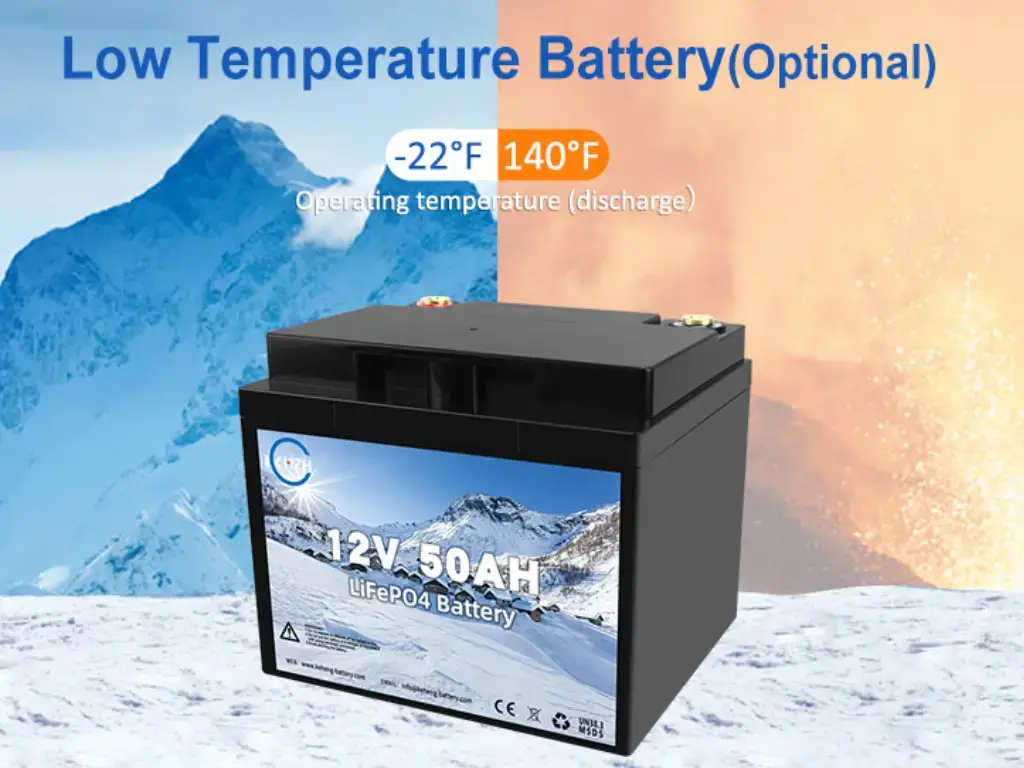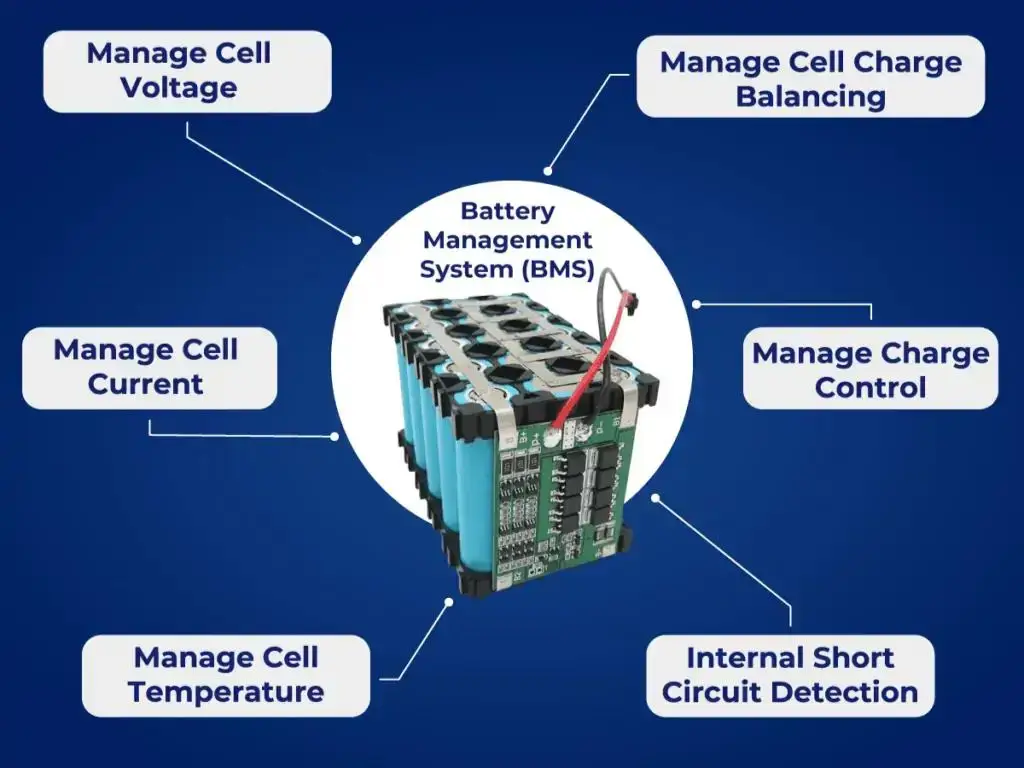Introduction
LiFePO4 batteries, which are also known as lithium iron phosphate batteries, are a kind of rechargeable battery that have a LiFePO4 as the cathode and a graphitic carbon electrode as the anode. LiFePO4 batteries are applicable in a variety of areas, including electric vehicles, renewable energy storage systems, emergency power supplies, and portable electronics. Their ability to withstand tough situations, safety features, high energy density and long service life make them the perfect option for applications where reliability and performance are the primary consideration.
Nevertheless, the working temperature range has a great impact on the LiFePO4 battery performance and life. This article will explore the temperature range in which LiFePO4 batteries work optimally and also how this range helps in their efficient operation and longer lifespan.
What is the Optimal Temperature Range of LiFePO4 Battery?
LiFePO4 batteries are recommended to be operated within a specific temperature range to maximize performance and lifespan. LiFePO4 batteries are usually designed to function within a temperature range of -20°C to 60°C (-4°F to 140°F). Within this range, the battery will be able to supply its rated capacity, keep a constant voltage and experience a negligible performance degradation over time.
It is worth mentioning that the range of temperature within which LiFePO4 batteries can operate ideally may differ slightly for different manufacturers and battery designs. Low temperature LiFePO4 battery of Keheng can work in a wide temperature range of -30°C to 60°C (-22°F to 140-°F), while others can only work in a narrower temperature spectrum. In order to get the precise temperature range for a particular LiFePO4 battery, it is necessary to refer to the manufacturer’s specifications and guidelines.
You May Like: Discover the Best Batteries for Cold Weather: An In-Depth Analysis

Low-Temperature Impact on LiFePO4 Batteries
Reduced Capacity
At low temperatures, the available capacity of LiFePO4 batteries will be reduced when they are running. The rate of the electrochemical reactions within the battery slows down when the temperature falls below the optimal range, which in turn leads to a decrease in the amount of energy that can be stored and subsequently released. For instance, a LiFePO4 battery capacity may be reduced by up to 20% at -20 °C (-4°F) compared to its rated capacity at room temperature.
Increased Internal Resistance
Low temperatures also cause an increase in the internal resistance of LiFePO4 batteries. The higher internal resistance hinders the flow of electrons and ions within the battery, leading to reduced performance and efficiency. At extremely low temperatures, such as -30°C (-22°F), the internal resistance of LiFePO4 batteries can increase by a factor of 2 to 3 compared to room temperature values. This increased resistance results in slower charging and discharging rates, as well as potential voltage drops under load.
Potential for Lithium Plating
Exposing LiFePO4 batteries to low temperatures, particularly during charging, can also increase the risk of lithium plating. Lithium plating occurs when lithium ions accumulate on the surface of the anode instead of intercalating into the graphite structure. This phenomenon is more likely to occur at low temperatures due to the reduced mobility of lithium ions.
Lithium plating is an issue that can cause growth of dendrites, thin, needle-like structures that can penetrate the separator, leading to short-circuits and eventually to thermal runaway. Moreover, lithium plating can be long-term damage to the battery capacity as it consumes active lithium that is supposed to be available for the charging and discharging cycles.
Decreased Charging Efficiency
The increased internal resistance and slowed diffusion of lithium ions at low temperatures also lead to decreased charging efficiency. When charging LiFePO4 batteries in cold environments, a larger portion of the input energy is dissipated as heat due to the higher internal resistance. This results in longer charging times and reduced overall energy efficiency. For example, a LiFePO4 battery that typically charges to 100% capacity in 2 hours at 25°C (77°F) may require 3-4 hours to reach the same state of charge when the temperature drops to 0°C (32°F).
Lower Discharge Plateau Voltage
Low temperatures also impact the discharge properties of LiFePO4 batteries. The plateau voltage of the battery discharge decreases as the temperature goes down. The discharge plateau voltage is the relatively flat portion of the battery’s voltage curve during discharge, where the voltage remains almost constant as the battery is drained. At lower temperatures, the discharge plateau voltage might be decreased by 10-20 mV per degree Celsius drop in temperature due to the increased internal resistance and slowed kinetics of the electrochemical reactions. This voltage drop might be a problem for the devices powered by LiFePO4 batteries, especially those with strict voltage requirements.
Reduced Rate Capability
The rate capability of LiFePO4 batteries, which implies their capability to deliver high currents, is also compromised at low temperatures. The increased internal resistance and decreased ionic conductivity impede the battery’s ability to maintain high discharge rate. For instance, a LiFePO4 battery which can provide a maximum continuous discharge current of 1C (1 times the rated capacity) at room temperature may only be able to deliver 0.5C or lower at temperatures below 0°C (32°F). This low rate capability can limit the performance of applications that require high power output in cold conditions.
High-Temperature Impact on LiFePO4 Batteries
Accelerated Aging
Exposing LiFePO4 batteries to high temperatures can significantly accelerate their aging process. Elevated temperatures promote various degradation mechanisms within the battery, leading to a faster decline in performance and capacity over time. Studies have shown that for every 10°C (18°F) increase in temperature above the optimal range, the lifespan of LiFePO4 batteries can be reduced by 30-50%. This means that operating a LiFePO4 battery at 60°C (140°F) can result in a lifespan that is only 50-70% of what would be expected at 25°C (77°F).
Increased Self-discharge
High temperatures also contribute to increased self-discharge rates in LiFePO4 batteries. Self-discharge refers to the gradual loss of charge that occurs even when the battery is not in use. At elevated temperatures, the rate of self-discharge accelerates, resulting in a faster depletion of the battery’s stored energy. For instance, a LiFePO4 battery stored at 40°C (104°F) may exhibit a self-discharge rate that is 2-3 times higher than when stored at 25°C (77°F). This increased self-discharge can lead to reduced battery capacity and shorter shelf life.
Risk of Thermal Runaway
Although LiFePO4 batteries are inherently safer than other lithium-ion chemistries, exposure to extremely high temperatures can still pose a risk of thermal runaway. Thermal runaway is a catastrophic event where the battery experiences uncontrolled heat generation, leading to a rapid increase in temperature and potentially causing fire, explosion, or the release of toxic gases. While the onset temperature for thermal runaway in LiFePO4 batteries is higher compared to other lithium-ion batteries, typically around 270°C (518°F), it is still crucial to avoid subjecting the battery to excessive heat to prevent such hazards.

Enhanced Electrolyte Decomposition
High temperatures can accelerate the decomposition of the electrolyte in LiFePO4 batteries. The electrolyte is a critical component that facilitates the transport of lithium ions between the electrodes. At elevated temperatures, the electrolyte can undergo irreversible chemical reactions, leading to the formation of unwanted byproducts and a decrease in ionic conductivity. This degradation of the electrolyte can result in reduced battery performance, capacity fade, and an increased risk of internal short circuits.
Changes in Electrode Material Structure
The LiFePO4 cathode material can also be affected by the high temperatures exposure which may lead to the changes in the crystal structure. The olivine structure of LiFePO4 will first begin to change into a disordered or amorphous state at a temperature above 60°C (140°F). The structural change in the cathode may cause instability and deterioration of the electrochemical properties of the cathode, which will result in the decline of the battery performance. Furthermore, high temperatures can contribute to the breakdown of the SEI layer (solid electrolyte interphase) on the anode side, thus exposing the graphite to additional side reactions and disintegration.
Reduced Mechanical Strength of Separator
The separator plays the role of a safety device in LiFePO4 batteries, it blocks the physical contact of the cathode and anode while letting the lithium ions flow through. Extreme temperatures can have the same effect on the separator’s mechanical strength and structural properties. When the temperature rises, the separator could become more vulnerable to softening, shrinking, or even melting, thus increasing the chance of internal short circuits.
LiFePO4 Battery Storage Temperature Considerations
Proper storage temperature is crucial for maintaining the health and performance of LiFePO4 batteries when they are not in use. Exposing batteries to extreme temperatures during storage can lead to irreversible capacity loss, reduced lifespan, and potential safety hazards.
Short-term Storage Temperature Range
For temporary storage, normally less than three months, the LiFePO4 batteries should be within the range of -20°C to 45°C (-4°F to 113°F). This temperature range eliminates the risk of degradation and makes sure the battery is in a stable state, usable whenever required.
It is vital to keep in mind that storing LiFePO4 batteries at the lower end of this temperature range, especially below 0°C (32°F), may cause temporary reduction in capacity and increased internal resistance. Nevertheless, these effects are mostly temporary and once the battery is brought back to room temperature and conditioned through a few charge-discharge cycles, the performance will return to normal.
Long-term Storage Temperature Range
For long-term storage, above 3 months, a narrower temperature range is recommended to minimize the effects of self-discharge and to maximize the battery’s capacity. The ideal long-term storage temperature range for LiFePO4 batteries is between 5°C and 25°C (41°F to 77°F), with the best option being around 15°C (59°F).
Storing LiFePO4 batteries in the range of temperatures between 0°C and 40°C may also help to lower the self-discharge rate and increase the storage life. Nevertheless, it is necessary to permit the battery to gradually warm up to the room temperature prior to using it, as charging or discharging a cold battery can cause the performance to decline and also may cause safety issues.
It is also important to keep the LiFePO4 batteries in storage in the SOC range between 50% and 70% for long periods of time. This SOC range will help to relieve the stress on the battery components and will also guard against over-discharge or overcharge during storage.
Early Warning Signs of Temperature-related Issues
- Rapid temperature rise: An over-heating battery during charging or discharging, which is a sign of internal short circuit, overloading or other faults, is a condition that should be addressed as soon as possible.
- Temperature gradients: Large temperature fluctuations between different parts of the battery pack are indications of uneven current distribution, localized heating or cooling system failures, and may result in rapid degradation and reduced performance.
- Persistent high temperature: In case the battery temperature stays more or less above the recommended operating range, even when there is no power load, it may show a problem with the thermal management system, for instance, a bad cooling fan or a blocked ventilation channel.
- Reduced performance at extreme temperatures: The most obvious symptom of temperature-related stress is when the battery capacity, power output, or charging speed is significantly reduced when the temperature is very low or high. This can eventually lead to permanent damage if not addressed in time.
Through careful monitoring of LiFePO4 battery temperature with sensors and BMS, and by being vigilant of early warning signs, users can take effective measures in advance to handle temperature-related problems, and thus ensure the safe and optimal performance of the battery throughout its lifespan.
Temperature-related Security Measures for LiFePO4 Batteries
Although LiFePO4 batteries are famous for their innate safety advantages over other lithium-ion chemistries, temperature-related safety precautions are still required to eliminate potential hazards. Here are some key things to keep in mind:
- Make sure that the battery works within the specified temperature range, and do not let it get near very hot sources.
- Establish a BMS system that is able to constantly check battery temperature and take corrective actions like discontinuing charge or discharge current if the temperature goes beyond the safe limits.
- Introduce the temperature sensors inside the battery pack that will allow the BMS to collect the accurate temperature data in real time.
- Implement correct thermal management tools, like heat sinks, cooling systems, phase change materials, to control the battery temperature and avoid any heat accumulation.
- Create battery pack with sufficient distance between cells and insert fire-resistant materials to limit the spreading of thermal runaway, should it happen.
- Do not allow the battery to come into direct sunlight, or any other heat source that can lead to the temperature exceeding the recommended limits.
- Proper insulation provides for the reduction of heat transfer from the battery to the environment thus eliminating the effect of external temperature changes on the battery’s performance.

Temperature Range Comparison: LiFePO4 vs. Other Battery Chemistries
The LiFePO4 batteries have specific thermal properties that differ from those of the other common battery chemistries. They have a wider operational temperature range and better performance at both low and high temperatures. This is the reason LiFePO4 batteries are highly preferred for applications that need to work flawlessly in a wide temperature range. Here is the table for you to learn the temperature range differences between li-po4 and other batteries that you can select the most suitable battery technology for their specific application and operation environment.
| Battery Chemistry | Optimal Operating Temperature Range | Low-Temperature Performance | High-Temperature Performance |
| LiFePO4 | -20°C to 60°C (-4°F to 140°F) | Good | Excellent |
| Lead-Acid | 20°C to 30°C (68°F to 86°F) | Poor | Fair |
| Nickel-Cadmium | -20°C to 45°C (-4°F to 113°F) | Fair | Good |
| Nickel-Metal Hydride | 10°C to 30°C (50°F to 86°F) | Fair | Poor |
| Lithium Cobalt Oxide | 10°C to 40°C (50°F to 104°F) | Poor | Fair |
| Lithium Nickel Manganese Cobalt Oxide | 15°C to 35°C (59°F to 95°F) | Poor | Fair |
Also Read: Gel vs Lithium Battery Showdown: Which Comes Out on Top?
Conclusion
Understanding and managing the temperature range of LiFePO4 batteries is the key to achieve the best performance, safety and lifetime. Keeping the batteries inside the recommended temperature range and implementing efficient thermal management techniques will help users to achieve reliable operation and extend the life of their LiFePO4 batteries.
Get a Free Quote with Keheng
Keheng is dedicated to offering LiFePO4 battery systems that are both high-performance, safe, and reliable. If you are interested in buying LiFePO4 batteries or need more information on how Keheng’s LiFePO4 battery solutions can match your specific needs, please don’t hesitate to contact us for a free quote. Our team of experts is available to help you to choose LiFePO4 battery products that are most suited to your application and also give guidance on temperature management strategies. We are looking forward to working with you and to provide the best LiFePO4 battery solutions for your energy storage purposes.




